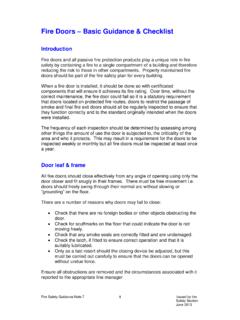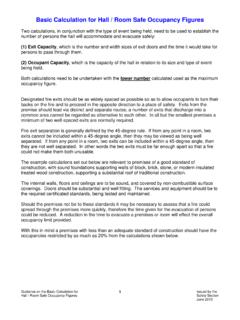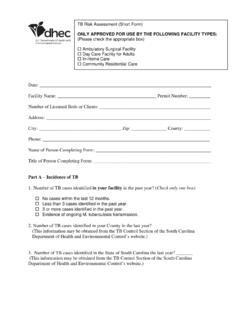Transcription of Personal Emergency Evacuation Plans (PEEPs)
1 Personal Emergency Evacuation Plans (PEEPs) In addition to guidance on fire safety produced by the Government there is a guide entitled Fire Safety Risk assessment Means of Escape for Disabled People (Supplementary Guide) which provides additional information on accessibility and means of escape for disabled people. It can be accessed and downloaded from: This supplementary guide must be complied with in its entirety and be used in conjunction with this document; other guides in the Fire Safety Risk assessment series; and other corporate guidance on fire safety. The supplementary guide can be used to assist in completing the record of significant findings from the fire safety risk assessment and should include a detailed account of the measures that are in place to facilitate and assist disabled people to leave the building.
2 The guide also provides examples and information to help carry out the fire safety risk assessment and record the Personal Emergency Evacuation Plans (PEEPs). It should be noted that the Fire Brigade s role in fire Evacuation is to ensure that the means of escape and associated fire safety measures provided for all those who may be in a building are both adequate and reasonable, taking into account the circumstances of each particular case. Under current fire safety legislation it is the responsibility of the person(s) having responsibility for the building to provide a fire safety risk assessment that includes an Emergency Evacuation plan for all people likely to be in the premises, including disabled people, and how that plan will be implemented.
3 Such an Evacuation plan should not rely upon the intervention of the Fire Brigade to make it work. The Disability Discrimination Act 1995 (DDA) does not make any change to these requirements, it underpins fire safety legislation by requiring employers and organisations providing services to the public to take responsibility for ensuring that all people, including disabled people, can leave the building safely in the event of a fire. Where an employer or service provider does not make provision for the safe Evacuation of disabled people from its premises, this may be viewed as discrimination. It may also constitute a failure to comply with the requirements of fire safety legislation.
4 Public bodies have additional duties that require them to proactively promote the equality of disabled people. This requires public bodies to do even more to ensure that disabled people do not face discrimination by not being provided with a safe Evacuation plan from a building. Personal Emergency Evacuation Plans (PEEPs) and Generic Emergency Evacuation Plans (GEEPs) A Personal Emergency Evacuation plan (PEEP) is a means by which arrangements are made to ensure that an individual s physical or mental abilities or other circumstances do not prevent this from happening. The responsible person should ensure that a PEEP is generated for every member of staff or student with a disability, where this may affect their ability to respond to an Emergency .
5 The PEEP shall set out the adjustments necessary for maintaining their Personal safety. The purpose of a Generic Emergency Evacuation plan (GEEP) is to enable visitors to the premises with restricted mobility or those who may not be able to evacuate unaided to become familiar with the layout, Evacuation procedures, available equipment and communication devices. It is the responsibility of Service Heads, Head Teachers, or any other persons with management responsibility for a service to ensure that the Emergency Evacuation Policy is implemented in all premises for which they have overall responsibility. The checklist below identifies key actions involved in ensuring adequate management of Emergency Evacuation arrangements for persons requiring assistance.
6 1. Have you identified all persons that may require assistance during an Evacuation , including those requiring assistance on a temporary basis /short term leg in cast? 2. Have you developed a Personal Emergency Evacuation plan (PEEP) with the person requiring assistance and did it include the staff that will be involved in the Evacuation for your school/area/building ( Evacuation assistants) and the premises manager? 3. Have Evacuation assistants been provided with all the relevant training and information to undertake their role including information on the structure of the building as it relates to Emergency Evacuation ; disability dignity and Evacuation etiquette?
7 4. Is there a system in place for Evacuation assistants to practice their skills and report back following Evacuation drills? 5. Have persons requiring a PEEP been consulted regarding involvement in an Evacuation drill? 6. If disabled persons cannot take part in an Evacuation drill has a system of communicating drills to such persons been established? 7. Has a system of testing Evacuation methods been put in place whether as part of a drill or otherwise? 8. Have all PEEPs for a building been reflected in the Evacuation plan for the building? 9. Is there a system of review in place for PEEPs, General Emergency Evacuation Plans (GEEPs) and building Evacuation Plans ?
8 10. Is Evacuation equipment inspected and maintained? 11. In public buildings have GEEPs been developed and made available for visitors? 12. Do meeting rooms have notices regarding Evacuation arrangements for people requiring assistance? If you have answered no to any of these questions further action must be taken to adequately manage the fire Evacuation provision. Personal Emergency Evacuation plan (PEEP) Forms The following forms are to be used when completing a Personal Emergency Evacuation plan (PEEP). PEEP 1 - Personal Emergency Evacuation plan Checklist PEEP 2 Personal Emergency Egress plan PEEP 3 Request for Reasonable Adjustments to Facilitate Emergency Evacuation of Disabled Persons from Council / School Premises PEEP 1 and PEEP 2 MUST be completed for all Personal Emergency Evacuation Plans PEEP 3 must be completed if PEEP 1 and PEEP 2 identify that reasonable adjustments are required.
9 PEEP 1 - Personal Emergency Evacuation plan Checklist Section 1 - General information Name of Assessor: Name of Person plan Prepared For: Assessed Person s Building / School: Date of assessment : Nature of Impairment(s)/Disability: Area(s) (1) Covered By The assessment : What times / days(2) are covered by this assessment ? Does the building Fire Risk assessment (3) denote that the proposed building has suitable access/egress. YES NO (1) The PEEP should, as far as practicable, be specific to individual areas of work / study / residence. However, if, for example, a number of activities are proposed to take place in adjacent areas from which escape will be effected using the same Emergency provisions then it may be possible to assess the provisions on one form.
10 Hearing impaired persons will normally be able to be assessed on one form since the provisions made for this class of persons are likely to be the same regardless of location. (2) It is important to distinguish in the PEEP whether the area to be accessed will be used inside or outside of normal working areas. It is likely that certain areas of buildings will be inaccessible outside of normal working hours to assure security. The PEEP needs to demonstrate that this has been adequately considered. (3) If a building assessment deems that a particular area does not meet the general access requirements for person being assessed then alternative management arrangements will need to be identified.








